
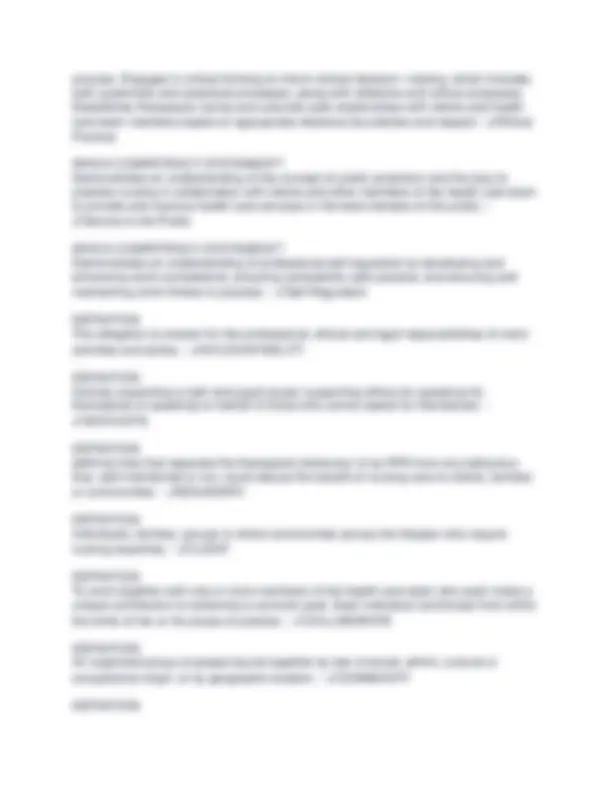
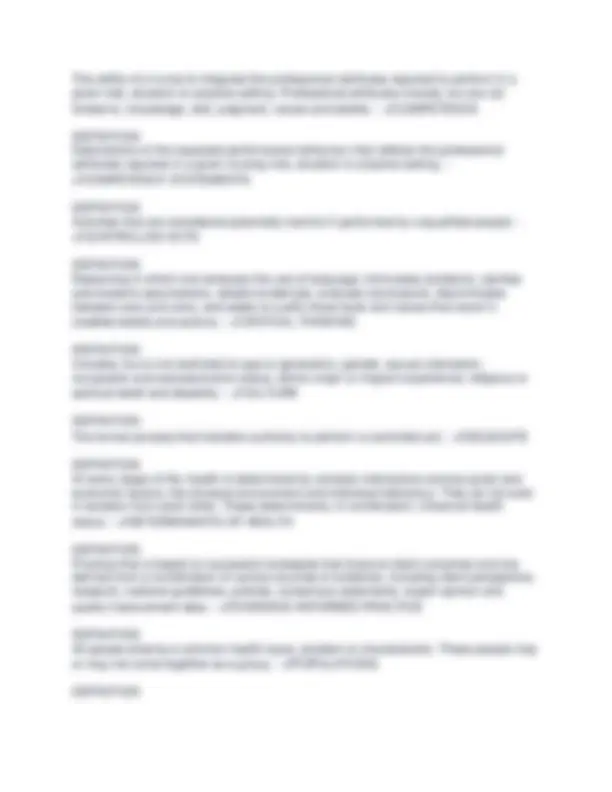
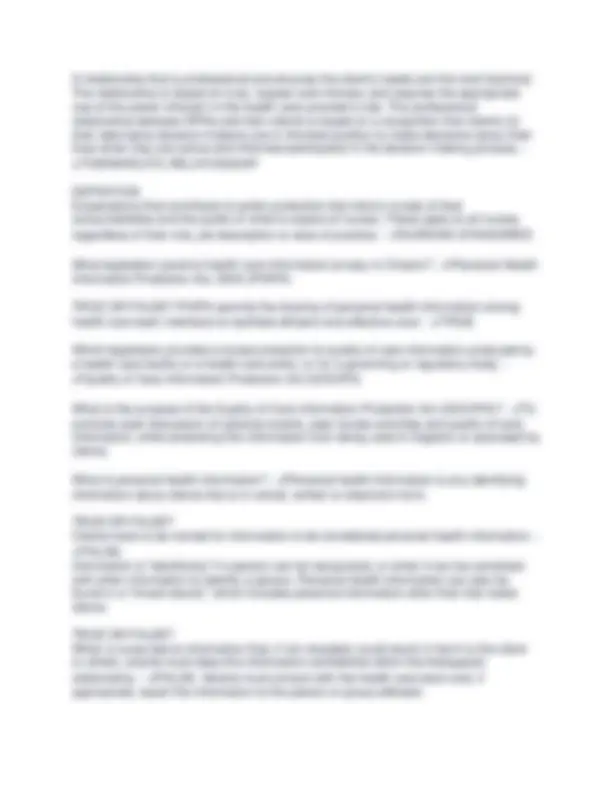

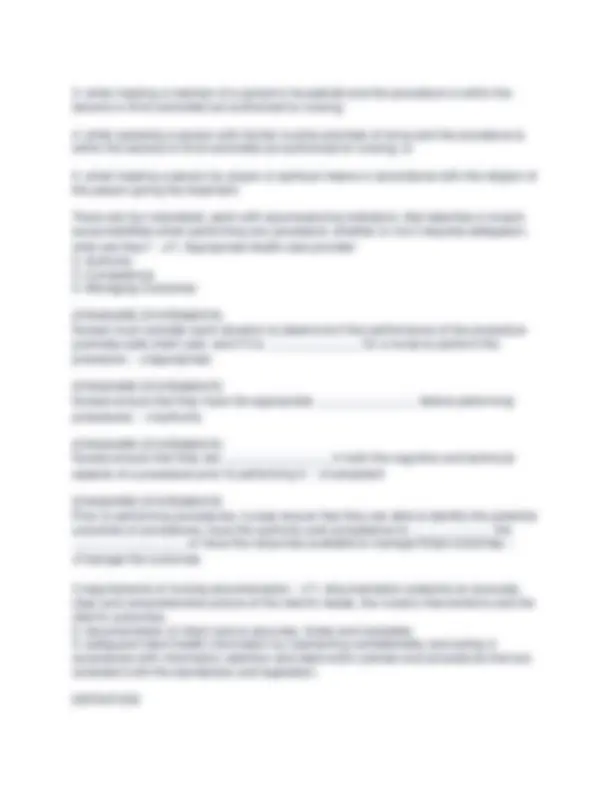
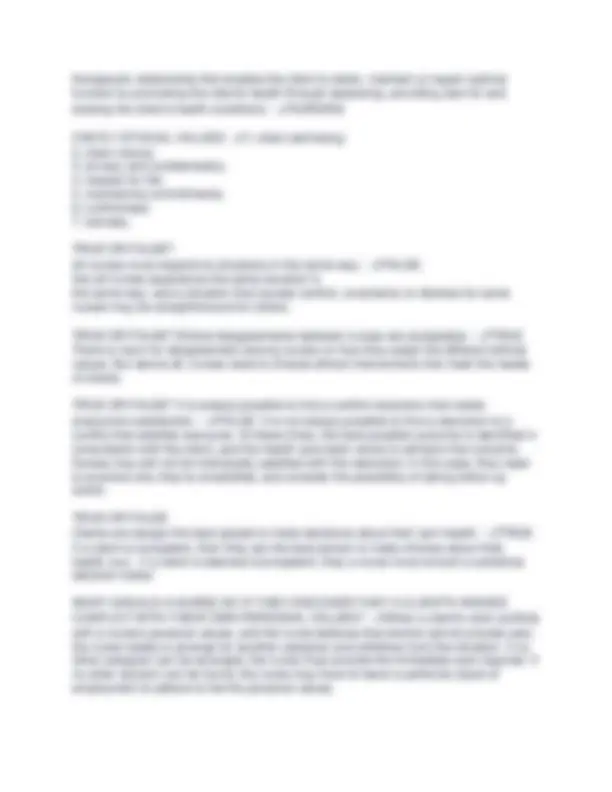
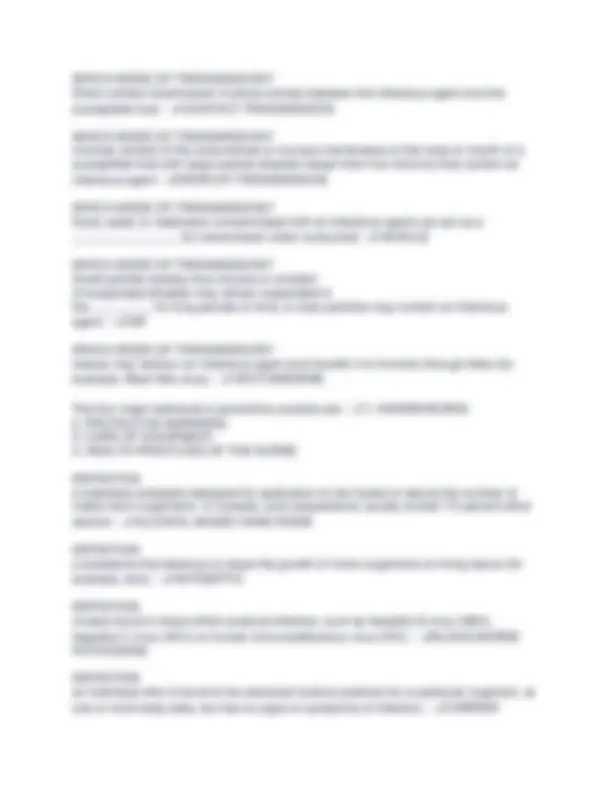
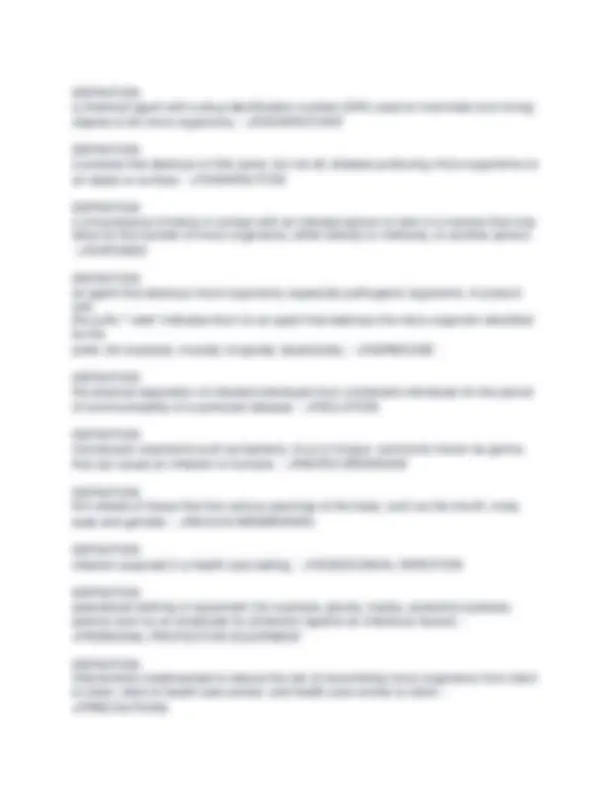
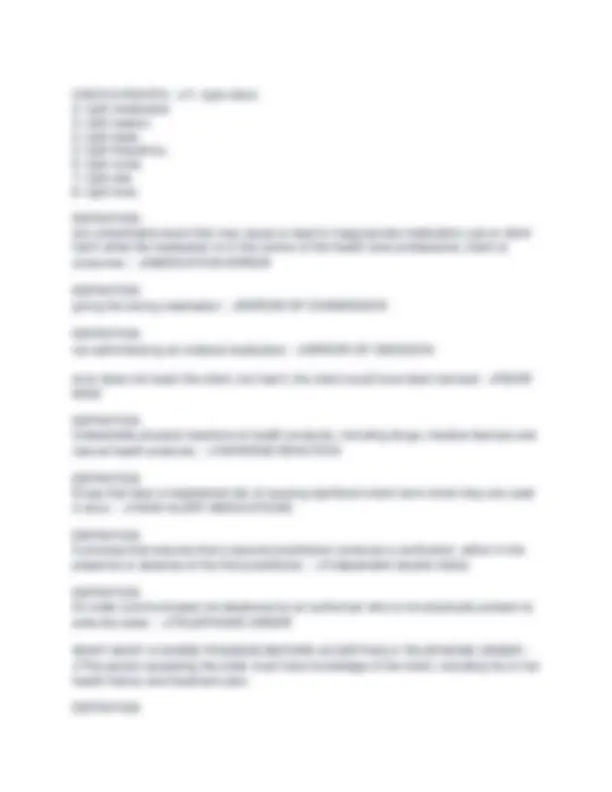
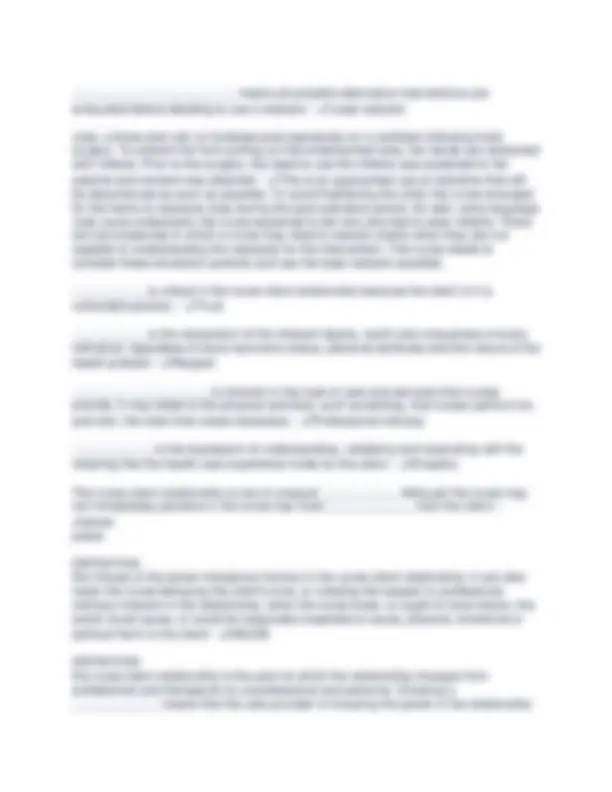
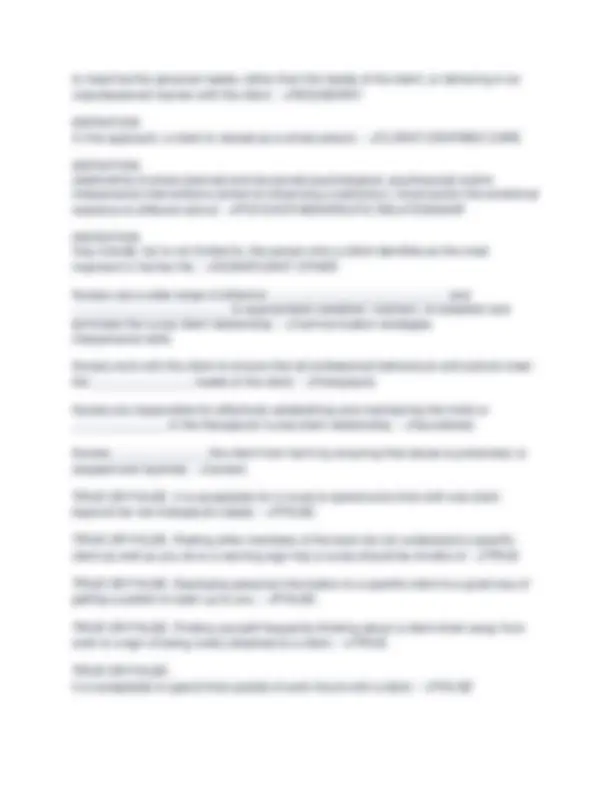

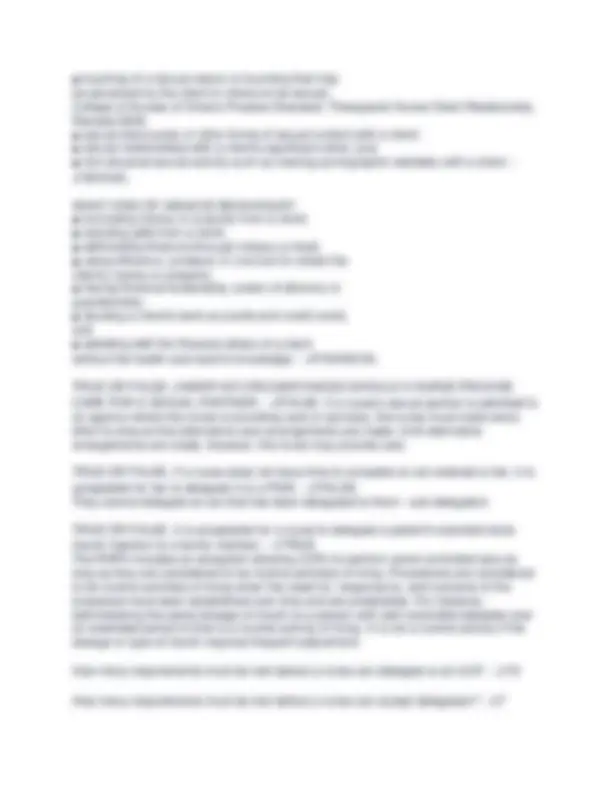
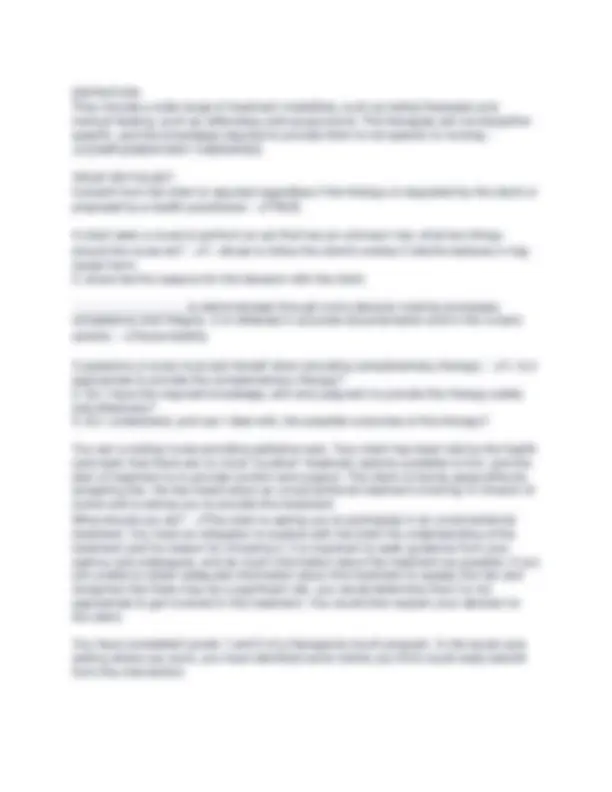
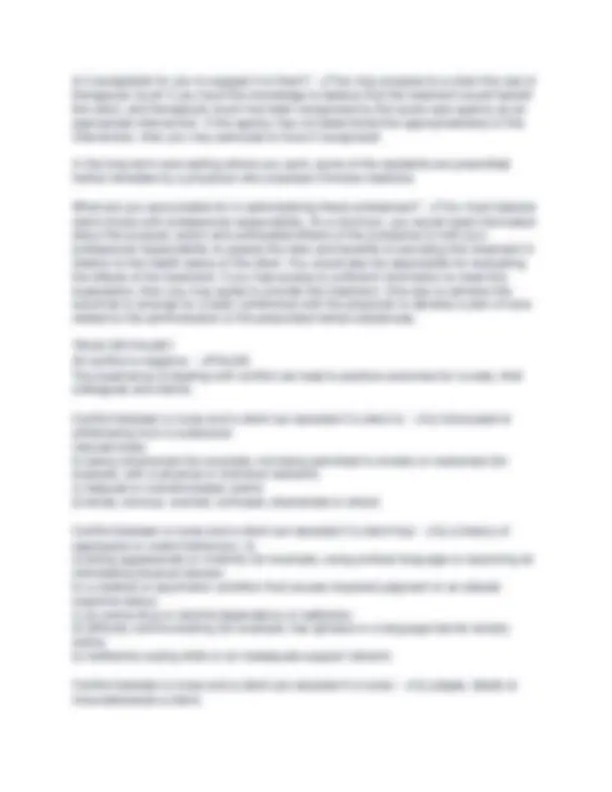
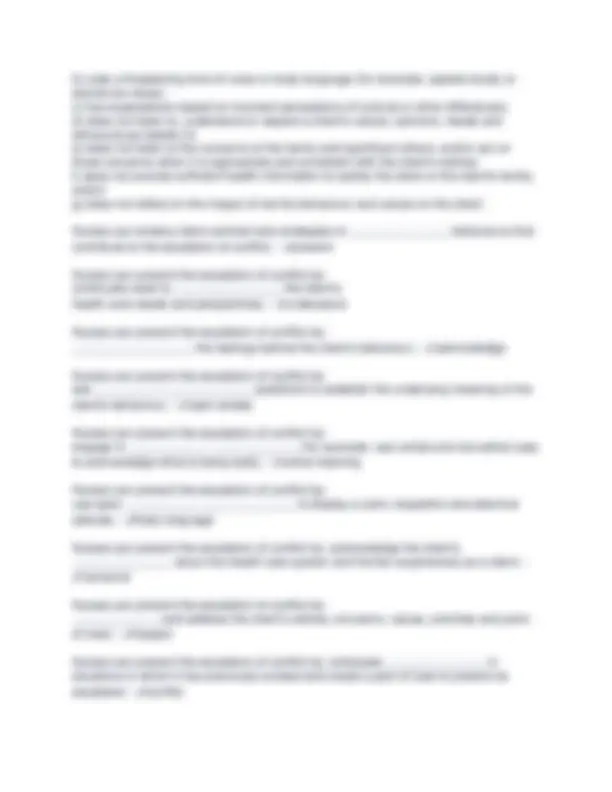
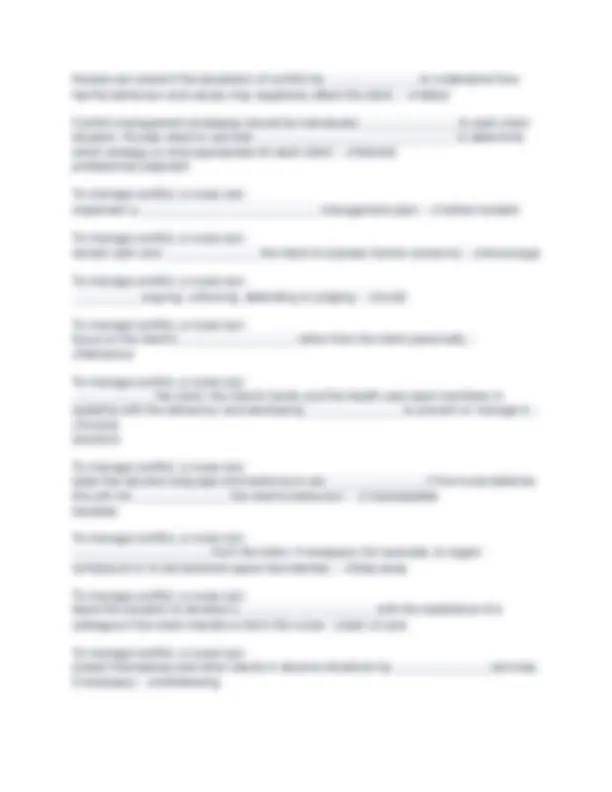
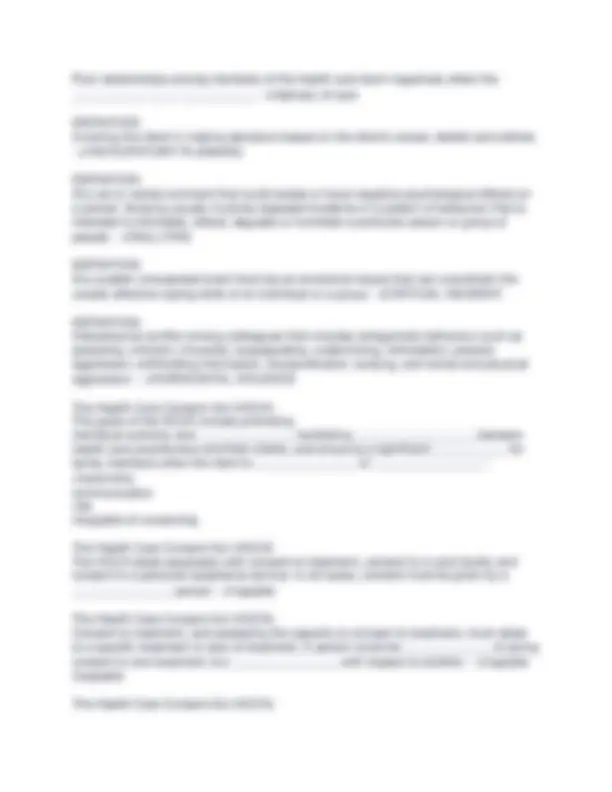
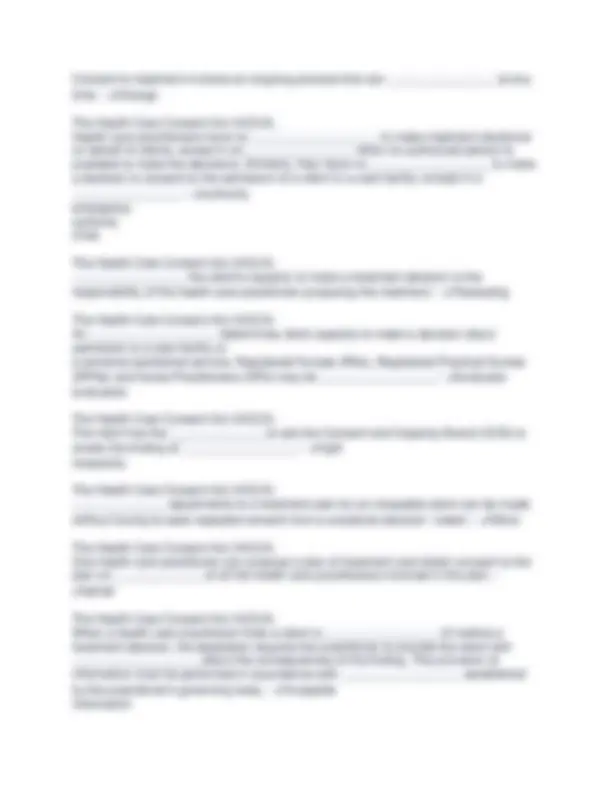
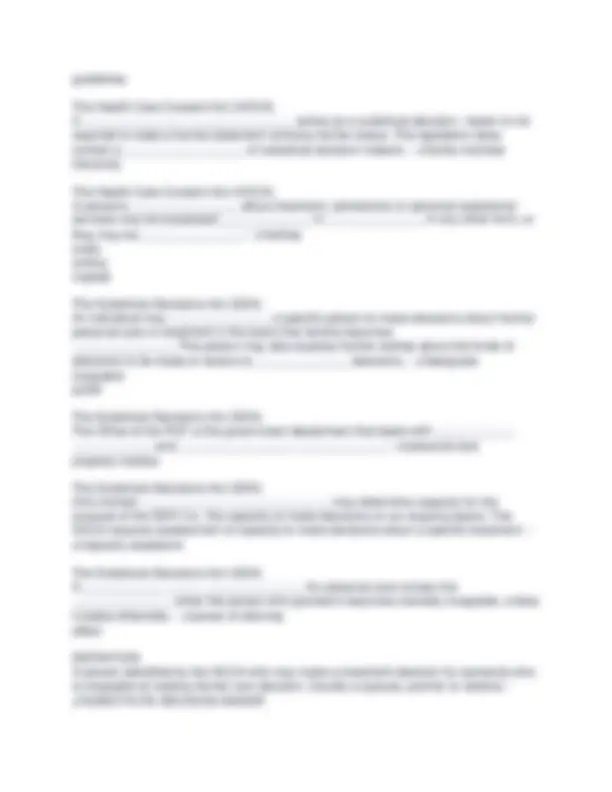
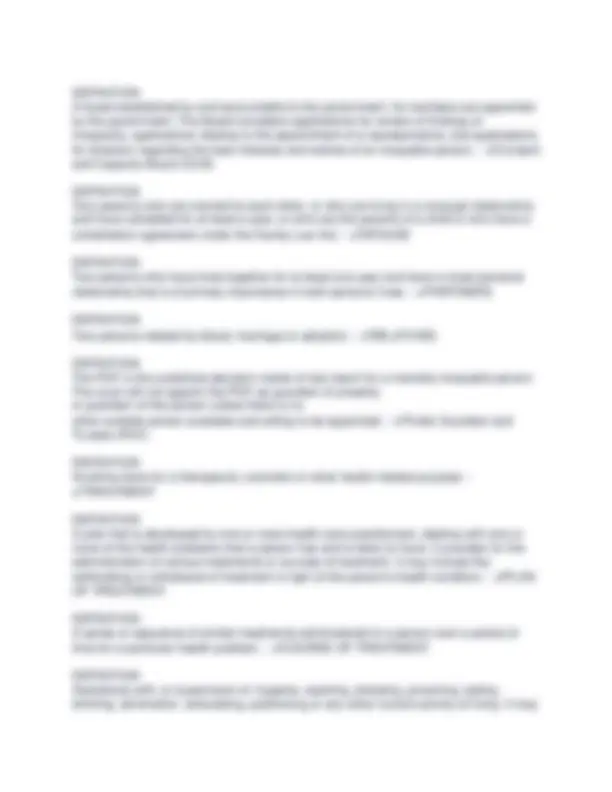
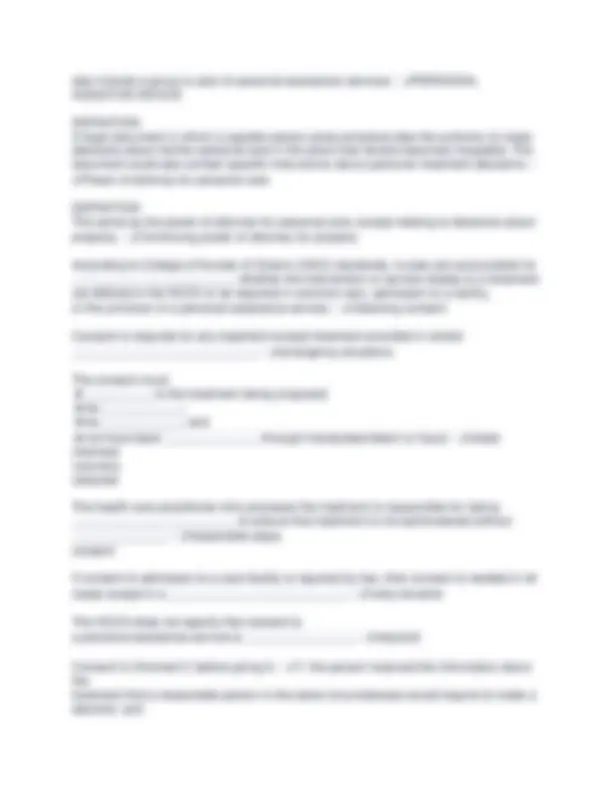
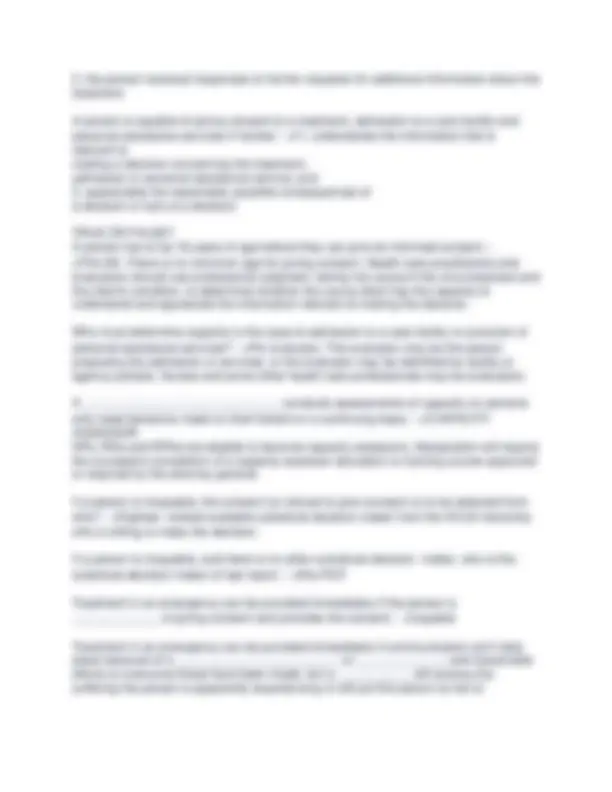
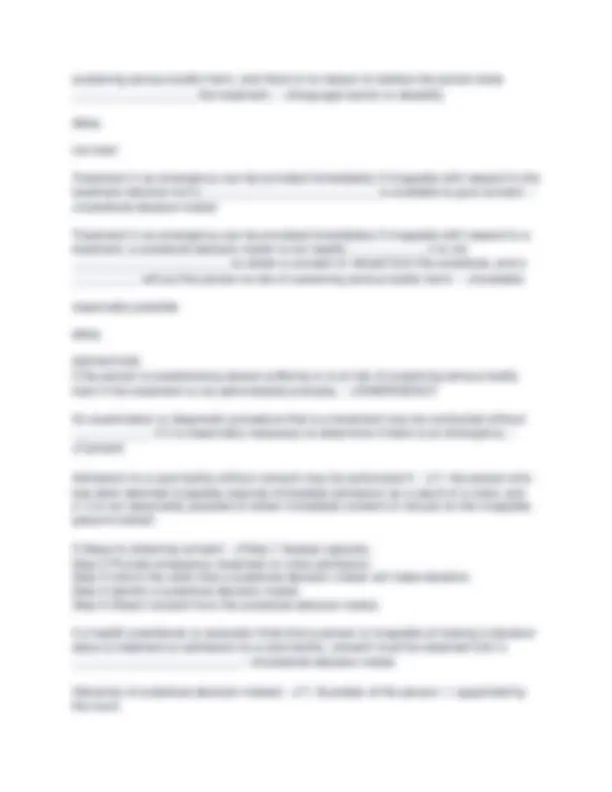
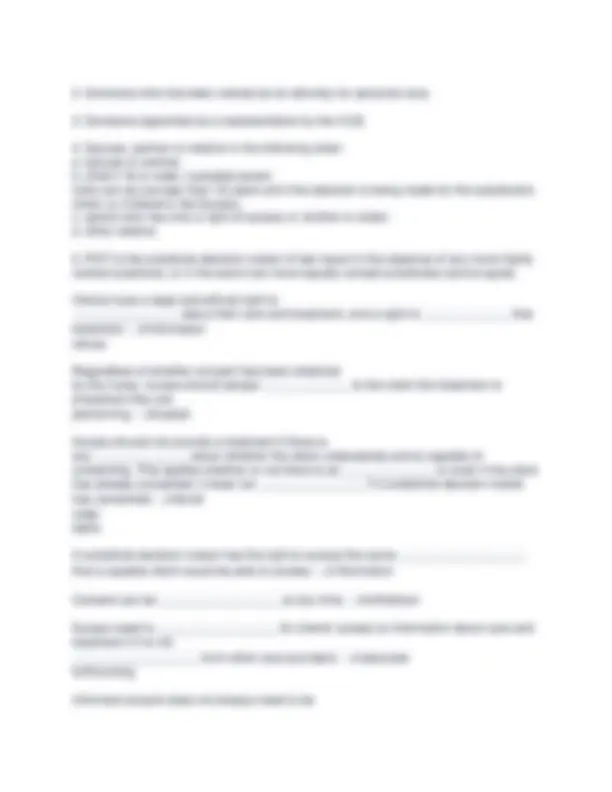
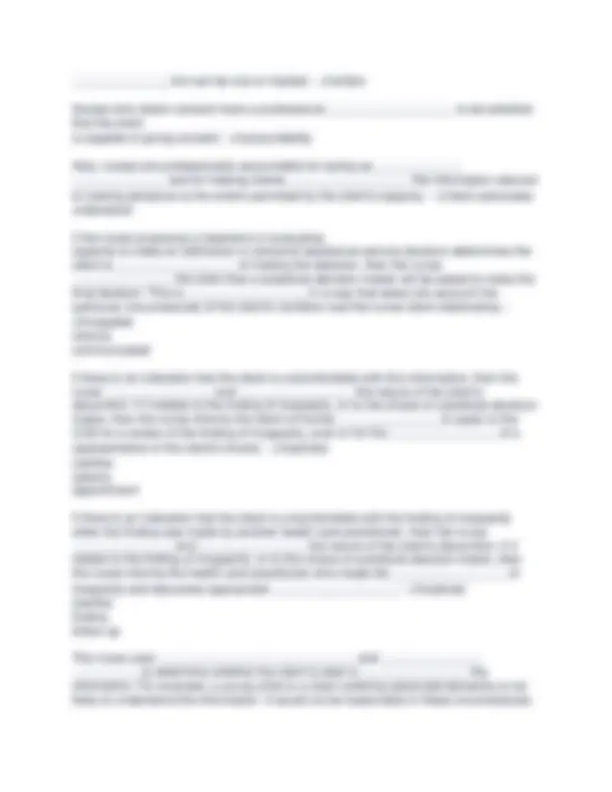
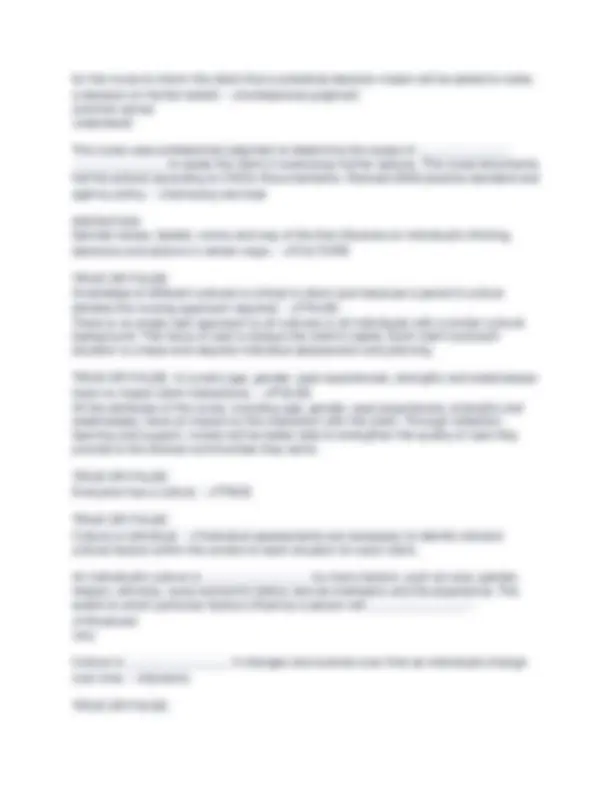
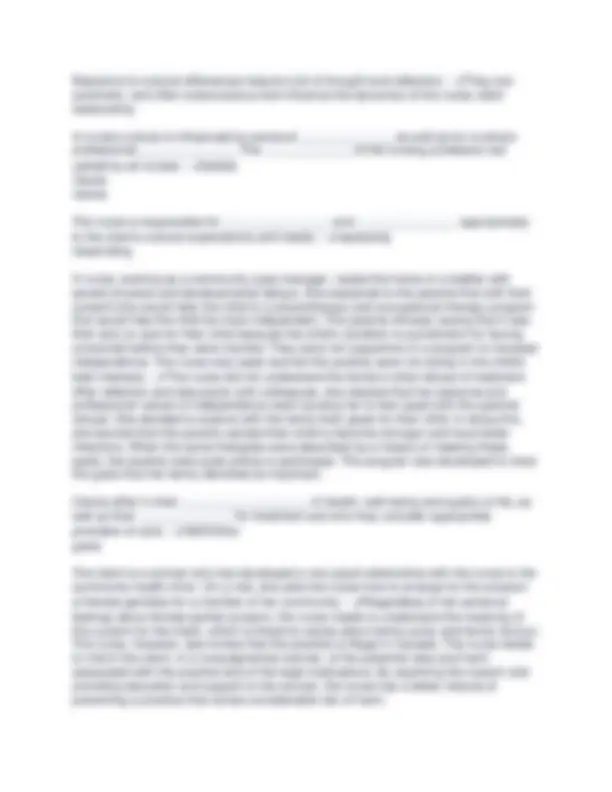
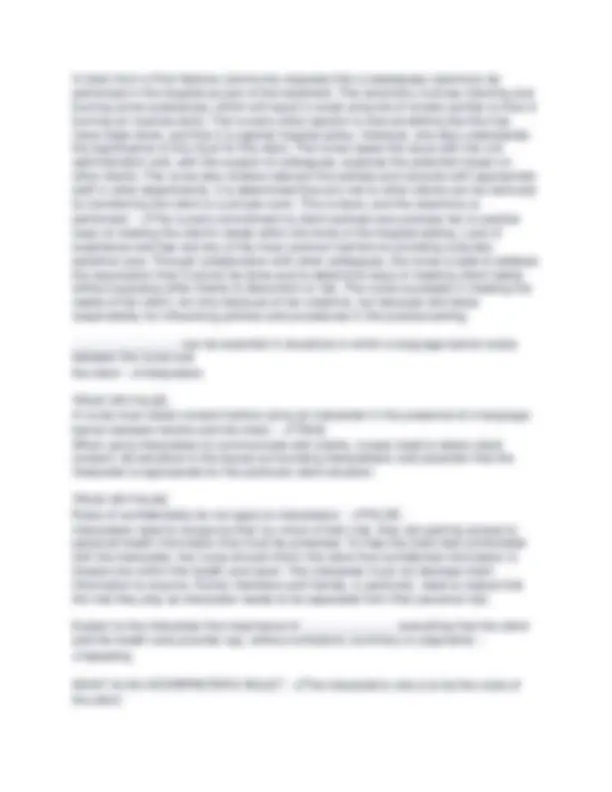
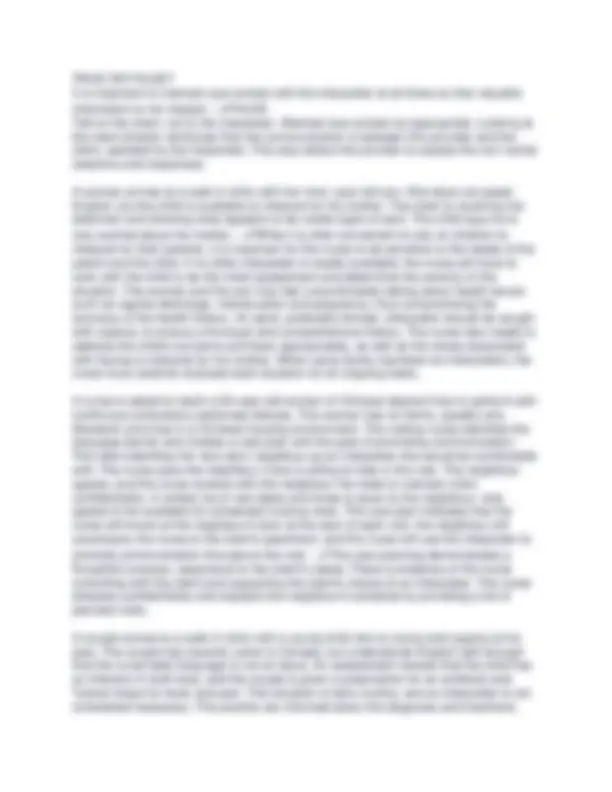
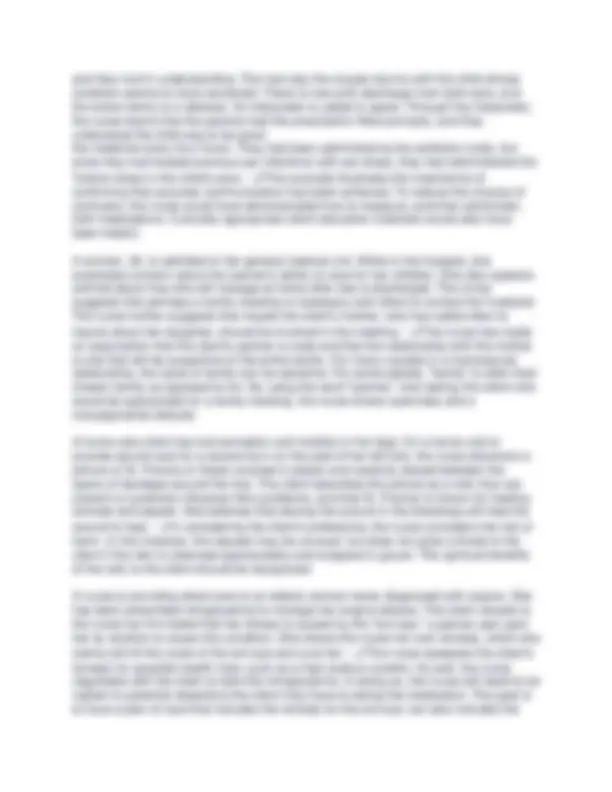
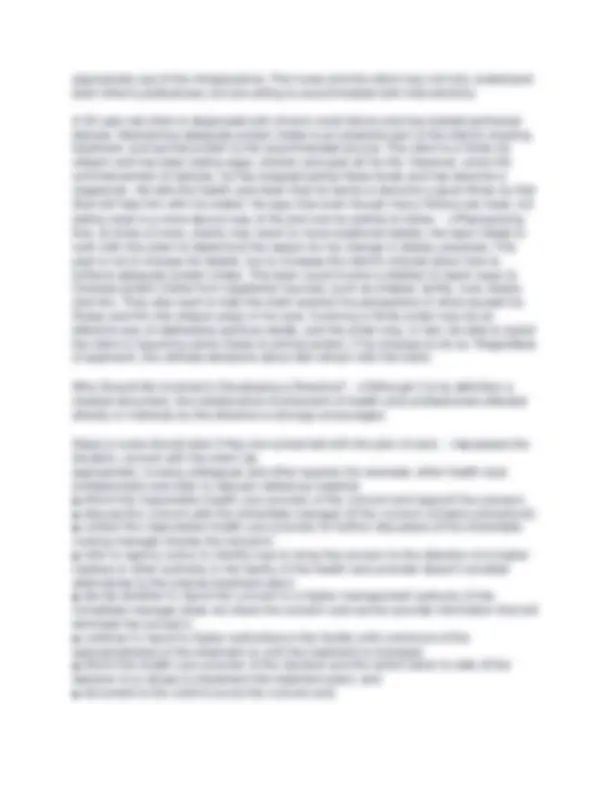
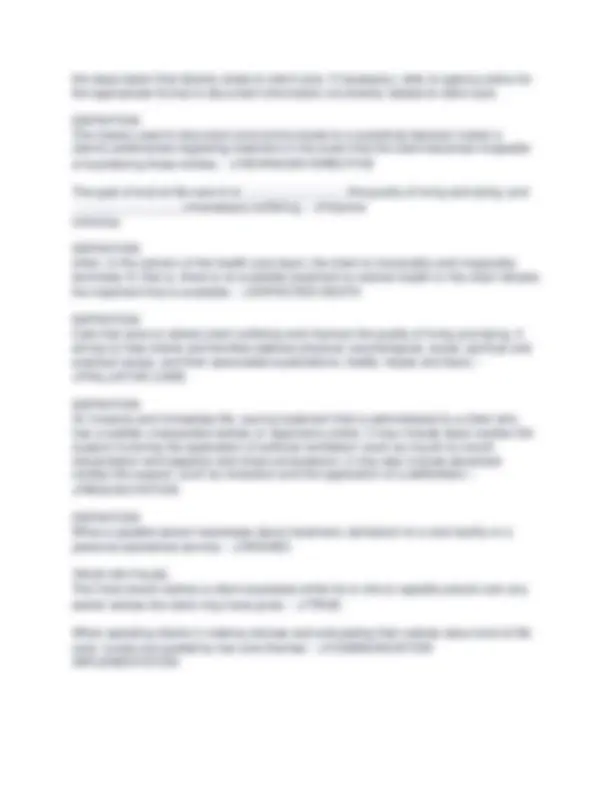
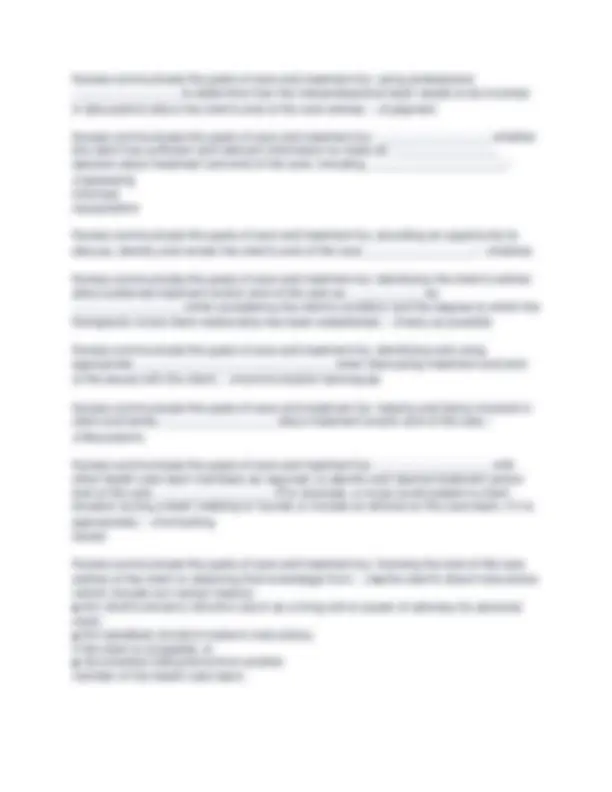
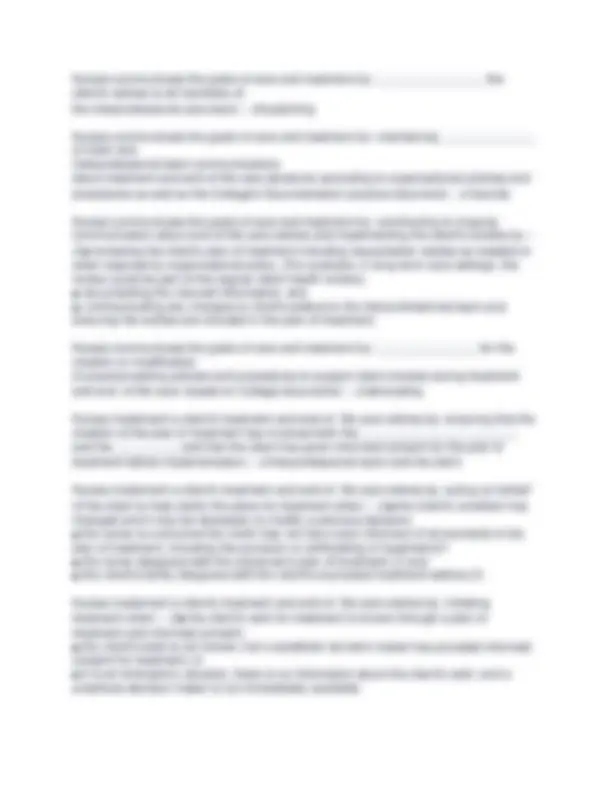
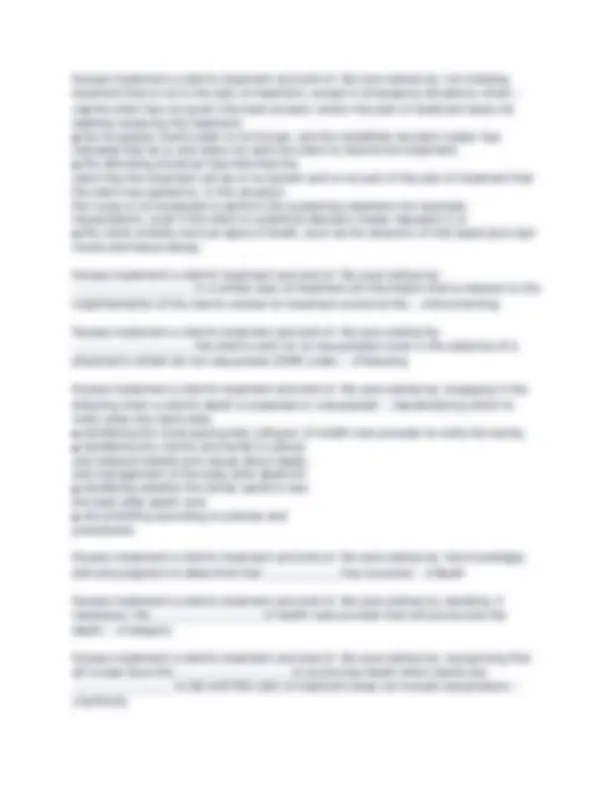
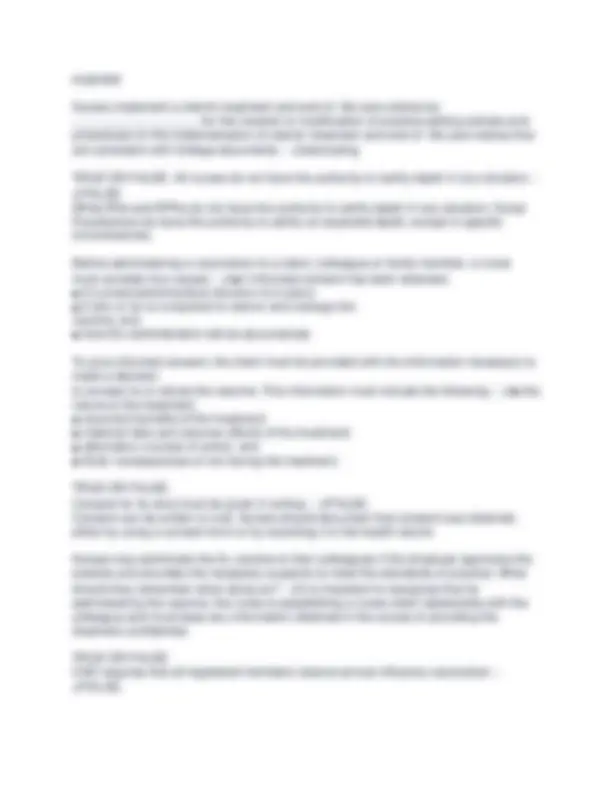
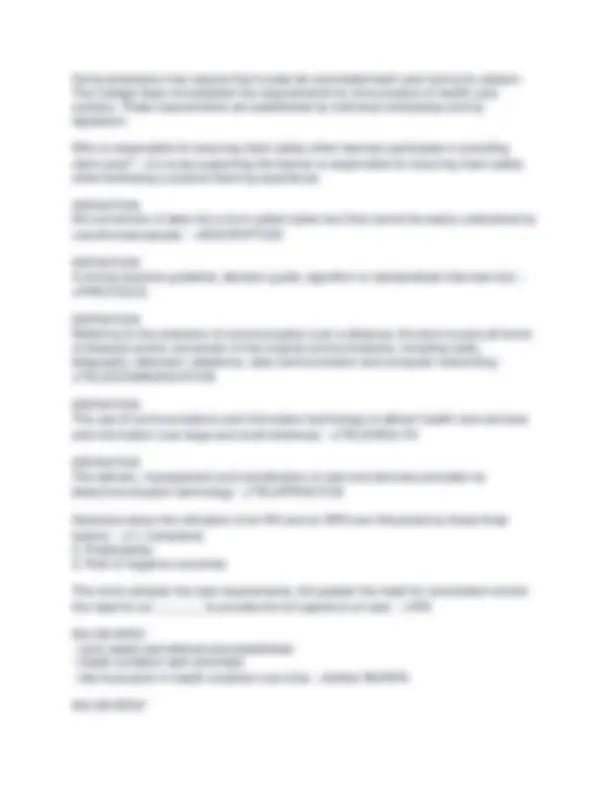
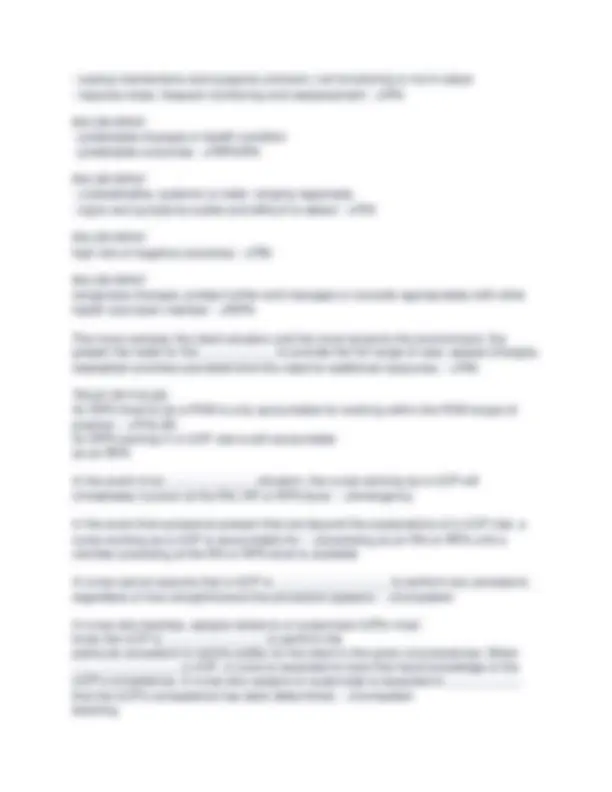
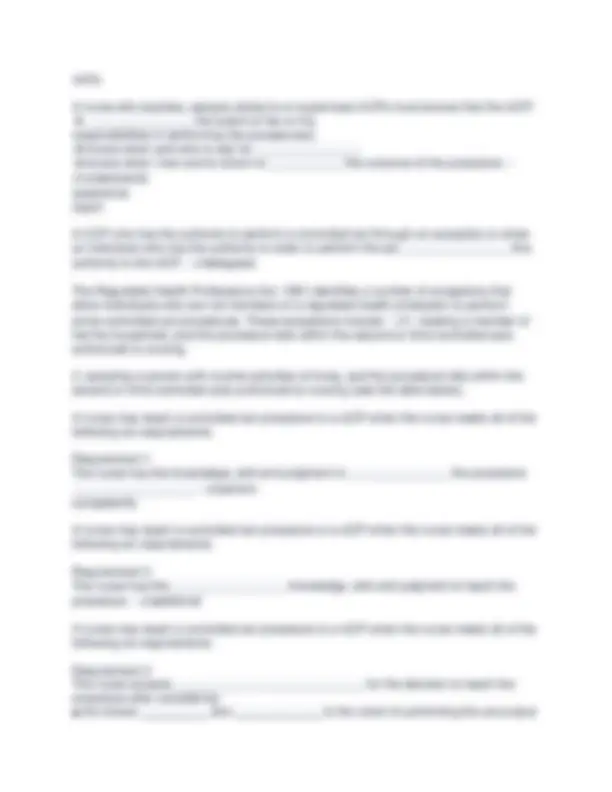
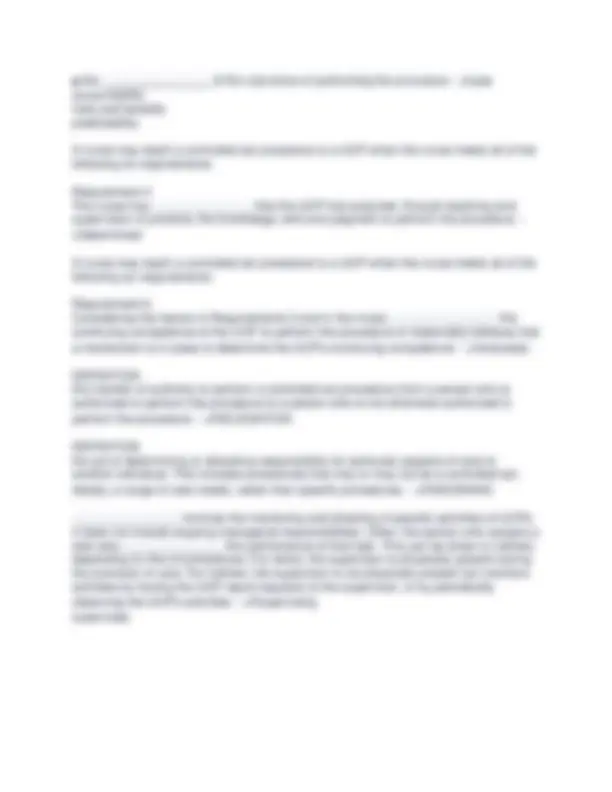


Study with the several resources on Docsity

Earn points by helping other students or get them with a premium plan


Prepare for your exams
Study with the several resources on Docsity

Earn points to download
Earn points by helping other students or get them with a premium plan
Community
Ask the community for help and clear up your study doubts
Discover the best universities in your country according to Docsity users
Free resources
Download our free guides on studying techniques, anxiety management strategies, and thesis advice from Docsity tutors
Definitions and guidelines for various concepts in nursing practice, including advocacy, determinants of health, personal protective equipment, plan of care, communication implementation, and end-of-life care. It covers topics such as obtaining consent, documenting client care, implementing treatment wishes, and dealing with conflict situations.
Typology: Exams
1 / 49

This page cannot be seen from the preview
Don't miss anything!










































CNO MISSION - ✔regulating nursing in the public interest 2 documents that provide the legislative framework for regulating nursing in Ontario: - ✔1. Regulated Health Professions Act, 1991
Entry-level RPNs enter into practice with competencies that are _______________ across diverse practice settings. - ✔transferable COMPETENCY ASSUMPTIONS Entry-level RPNs have a _______________ ___________ in nursing, health and social sciences, ethics, leadership and research. - ✔knowledge base COMPETENCY ASSUMPTIONS Entry-level RPNs are committed to engaging in quality assurance practices, including ____________ _____________. - ✔Reflective Practice COMPETENCY ASSUMPTIONS Entry-level RPNs use ____________ _______________ skills to support clinical decision-making and reflect upon practice experiences. - ✔critical thinking The entry-level RPN is accountable for: All client __________ she or he provides. - ✔care The entry-level RPN is accountable for: All decisions about _____________ _________ to other care providers - ✔assigning care The entry-level RPN is accountable for: Knowing and recognizing her or his _______________ __________ (knowledge, skill and judgment) when making decisions and providing care to clients. - ✔competence level The entry-level RPN is accountable for: Actively identifying and asking ________________ of self, colleagues (including members of the Interprofessional health care team) and clients. - ✔questions The entry-level RPN is accountable for: The application of _____________ to ______________ via the use of critical thinking and problem-solving skills consistent with the RPN's educational preparation. - ✔theory to practice WHICH COMPETENCY STATEMENT? Demonstrates professional conduct; practises in accordance with legislation and the standards as determined by the regulatory body and the practice setting; and demonstrates that the primary duty is to the client to ensure consistently safe, competent and ethical care - ✔Professional Responsibility and Accountability WHICH COMPETENCY STATEMENT? Demonstrates competence in professional judgments and practice decisions by applying principles implied in the ethical framework, and by using knowledge from many
The ability of a nurse to integrate the professional attributes required to perform in a given role, situation or practice setting. Professional attributes include, but are not limited to, knowledge, skill, judgment, values and beliefs. - ✔COMPETENCE DEFINITION Descriptions of the expected performance behaviour that reflects the professional attributes required in a given nursing role, situation or practice setting. - ✔COMPETENCY STATEMENTS DEFINITION Activities that are considered potentially harmful if performed by unqualified people. - ✔CONTROLLED ACTS DEFINITION Reasoning in which one analyzes the use of language, formulates problems, clarifies and explains assumptions, weighs evidences, evaluate conclusions, discriminates between pros and cons, and seeks to justify those facts and values that result in credible beliefs and actions. - ✔CRITICAL THINKING DEFINITION Includes, but is not restricted to age or generation, gender, sexual orientation, occupation and socioeconomic status, ethnic origin or migrant experience, religious or spiritual belief and disability. - ✔CULTURE DEFINITION The formal process that transfers authority to perform a controlled act. - ✔DELEGATE DEFINITION At every stage of life, health is determined by complex interactions among social and economic factors, the physical environment and individual behaviour. They do not exist in isolation from each other. These determinants, in combination, influence health status. - ✔DETERMINANTS OF HEALTH DEFINITION Practice that is based on successful strategies that improve client outcomes and are derived from a combination of various sources of evidence, including client perspective, research, national guidelines, policies, consensus statements, expert opinion and quality improvement data. - ✔EVIDENCE-INFORMED PRACTICE DEFINITION All people sharing a common health issue, problem or characteristic. These people may or may not come together as a group. - ✔POPULATIONS DEFINITION
A relationship that is professional and ensures the client's needs are first and foremost. The relationship is based on trust, respect and intimacy and requires the appropriate use of the power inherent in the health care provider's role. The professional relationship between RPNs and their clients is based on a recognition that clients (or their alternative decision-makers) are in the best position to make decisions about their lives when they are active and informed participants in the decision-making process. - ✔THERAPEUTIC RELATIONSHIP DEFINITION Expectations that contribute to public protection that inform nurses of their accountabilities and the public of what to expect of nurses. These apply to all nurses regardless of their role, job description or area of practice. - ✔NURSING STANDARDS What legislation governs health care information privacy in Ontario? - ✔Personal Health Information Protection Act, 2004 (PHIPA) TRUE OR FALSE? PHIPA permits the sharing of personal health information among health care team members to facilitate efficient and effective care. - ✔TRUE Which legislation provides a broad protection to quality of care information produced by a health care facility or a health care entity, or for a governing or regulatory body. - ✔Quality of Care Information Protection Act (QOCIPA) What is the purpose of the Quality of Care Information Protection Act (QOCIPA)? - ✔To promote open discussion of adverse events, peer review activities and quality of care information, while protecting this information from being used in litigation or accessed by clients. What is personal health information? - ✔Personal health information is any identifying information about clients that is in verbal, written or electronic form. TRUE OR FALSE? Clients have to be named for information to be considered personal health information. - ✔FALSE. Information is "identifying" if a person can be recognized, or when it can be combined with other information to identify a person. Personal health information can also be found in a "mixed record," which includes personal information other than that noted above. TRUE OR FALSE? When a nurse learns information that, if not revealed, could result in harm to the client or others, she/he must keep this information confidential within the therapeutic relationship. - ✔FALSE. He/she must consult with the health care team and, if appropriate, report the information to the person or group affected.
the correction the client requested, you could have the client write a correction and include it with the record or make the changes yourself. If you did not agree with the correction the client requested, then you can have the client make a note and append it to the record. You can then make a separate note regarding the client's request in the health record. A client does not have the right to correct an opinion or professional judgment by a health care professional. Because this is a note by another health care professional (the consulting physician), you cannot be certain about the accuracy of the information that the client wants corrected. You have two options in this case: you can either contact the health care professional who wrote the note and have this physician speak with the client about the corrections; or you can speak with the person responsible for ensuring compliance with PHIPA in your practice setting. You are an OHN. The manager of an employee who is your client has asked questions about the client's health condition. The manager has also asked if the client has medical notes to substantiate absences on particular dates. Can you provide this information to the manager? - ✔There are two issues here. The first is what is included in the definition of personal health information; the second is if a manager has access to personal health information. Medical notes to substantiate the employee's absences may be held in an employee's health file. If the medical note does not contain other personal health information (e.g., symptoms, treatment, diagnosis), then this information can be provided to the manager. Information concerning accommodation for the employee's needs may be given so the employer can make provisions to meet these needs. Accommodation information does not include the nature of the illness or the diagnosis. If there is personal health information included in the note, then the OHN can only provide the information that there were notes to substantiate the absences on the applicable dates. The manager is not entitled to any personal health information. This includes information about the nature of the illness, the diagnosis, the plan of treatment or any care provided; therefore, you cannot respond to any questions about the nature of the illness(es) or health condition(s). In this example, the nurse is the custodian and is responsible for maintaining the confidentiality of the client's personal health information. Providing information to the employer without the client's express consent is a breach of PHIPA. However, if a client would like personal health information to be given to the employer, then the client must give express consent to the nurse. In obtaining express consent, the nurse needs to clarify exactly which information the client is requesting be disclosed, and obtain written express consent that includes the employee's specific request. DEFINITION means by which the authority to perform a procedure is obtained or the decision is made to perform a procedure - ✔AUTHORIZING MECHANISM
formal process that transfers the authority to perform a controlled act - ✔DELEGATION DEFINITION A client-specific order can be an order for a procedure, treatment, drug or intervention for an individual client - ✔DIRECT CLIENT ORDER DEFINITION an order for a procedure, treatment, drug or intervention that may be implemented for a number of clients when specific conditions are met and specific circumstances exist - ✔DIRECTIVE DEFINITION a prescription for a procedure, treatment, drug or intervention - ✔ORDER Which legislation contains a scope of practice statement that describes in a general way what the profession does and the methods that it uses? - ✔NURSING ACT WHAT IS "The practice of nursing is the promotion of health and the assessment of, the provision of, care for, and the treatment of, health conditions by supportive, preventive, therapeutic, palliative and rehabilitative means in order to attain or maintain optimal function." - ✔SCOPE OF PRACTICE STATEMENT HOW MANY CONTROLLED ACTS ARE SPECIFIED BY THE Regulated Health Professions Act, 1991? - ✔ 13 HOW MANY CONTROLLED ACTS CAN A NURSE PERFORM? - ✔ 3 WHAT ARE THE 3 CONTROLLED ACTS THAT NURSES CAN PERFORM? - ✔1. Performing a prescribed procedure below the dermis or a mucous membrane.
therapeutic relationship that enables the client to attain, maintain or regain optimal function by promoting the client's health through assessing, providing care for and treating the client's health conditions. - ✔NURSING CNO'S 7 ETHICAL VALUES - ✔1. client well-being;
facilitating the client's health and welfare, and preventing or removing harm. - ✔CLIENT WELL-BEING WHICH ETHICAL VALUE? self-determination and includes the right to the information necessary to make choices and to consent to or refuse care - ✔CLIENT CHOICE WHICH ETHICAL VALUE? limited access to a person, the person's body, conversations, bodily functions or objects immediately associated with the person - ✔PRIVACY AND CONFIDENTIALITY WHICH ETHICAL VALUE? means that human life is precious and needs to be respected, protected and treated with consideration - ✔RESPECT FOR LIFE WHICH ETHICAL VALUE? keeping promises, being honest and meeting implicit or explicit obligations toward their clients, themselves, each other, the nursing profession, other members of the health care team and quality practice settings. - ✔MAINTAINING COMMITMENTS WHICH ETHICAL VALUE? speaking or acting without intending to deceive. - ✔TRUTHFULLNESS TRUE OR FALSE. Omissions are as untruthful as false information. - ✔TRUE. WHICH ETHICAL VALUE? allocating health care resources on the basis of objective health-related factors - ✔FAIRNESS TRUE OR FALSE. In regards to ethical concerns, sometimes the best possible outcome may be the one that is least bad. - ✔TRUE. Sometimes a completely good outcome is impossible One of Joanne's clients in the psychiatric unit, John, confides to her that he is fascinated by young children, boys and girls. He tells Joanne he is afraid that he will hurt a child some day. Joanne brings that information to the team. A short time later, John is discharged. Some weeks following his discharge, Joanne notices that John is the ice-cream vendor in her neighbourhood. She is concerned for the children in the neighbourhood, her own as well as the others, and wonders what she should do. - ✔A. ASSESS There is no absolute duty to respect confidentiality. Confidential information can be disclosed when a person(s) is at serious risk. However, it is preferable if the client discloses the information. Joanne decides that she needs to know more about John's
Direct contact transmission involves contact between the infectious agent and the susceptible host. - ✔CONTACT TRANSMISSION WHICH MODE OF TRANSMISSION? involves contact of the conjunctivae or mucous membranes of the nose or mouth of a susceptible host with large particle droplets (larger than five microns) that contain an infectious agent - ✔DROPLET TRANSMISSION WHICH MODE OF TRANSMISSION? Food, water or medication contaminated with an infectious agent can act as a ________________ for transmission when consumed - ✔VEHICLE WHICH MODE OF TRANSMISSION? Small particle residue (five microns or smaller) of evaporated droplets may remain suspended in the _________ for long periods of time, or dust particles may contain an infectious agent. - ✔AIR WHICH MODE OF TRANSMISSION? insects may harbour an infectious agent and transfer it to humans through bites (for example, West Nile virus). - ✔VECTORBORNE The four major elements to preventive practice are: - ✔1. HANDWASHING
a chemical agent with a drug identification number (DIN) used on inanimate (non-living) objects to kill micro-organisms. - ✔DISINFECTANT DEFINITION a process that destroys or kills some, but not all, disease-producing micro-organisms on an object or surface. - ✔DISINFECTION DEFINITION a circumstance of being in contact with an infected person or item in a manner that may allow for the transfer of micro-organisms, either directly or indirectly, to another person.
An interactive process of transferring client-specific information from one caregiver to another or from one team of caregivers to another for the purpose of ensuring the continuity of care and the safety of the client - ✔TRANSFER OF ACCOUNTABILITY DEFINITION An order that is communicated by an authorizer who is present in the practice environment but is unable to document the order. - ✔VERBAL ORDER MEDICATION TERMS The administration of an allergen by oral, inhaled or other route in which a positive test is a significant allergic response (for example, anaphylactic shock). - ✔Allergy challenge testing MEDICATION TERMS a prick/puncture procedure to determine allergies, if any. - ✔ALLERGY TESTING MEDICATION TERMS an intracutaneous injection to desensitize to an allergen - ✔DESENSITIZING INJECTION Because allergy testing and desensitizing injections carry a risk of adverse reactions, nurses must be able to do what? - ✔recognize side effects, intervene in the event of complications (for example, difficulty breathing, rash or anaphylactic shock) and manage outcomes. MEDICATION TERMS Any type of drug that the federal government has categorized as having a higher-than- average potential for abuse or addiction. Such drugs are divided into categories based on their potential for abuse or addiction. - ✔CONTROLLED SUBSTANCE MEDICATION TERMS A vaccine. - ✔IMMUNIZING AGENT MEDICATION TERMS Medications and preparations that do not require a prescription; for example, herbal therapies and acetaminophen. - ✔OVER THE COUNTER (OTC) DEFINITIONS A pharmacologically inert substance that has no physiological effect. - ✔PLACEBO DEFINITION Medications that are prescribed and administered as needed. - ✔PRN MEDICATION DEFINITION
Dosages, frequencies or routes that are prescribed in ranges (for example, Gravol 50- 100 mg for nausea). - ✔RANGE DOSES Most medications are not prescribed in range doses; however, range doses are used in situations in which the need for the amount of a drug varies from day to day or within the same day. Range doses give nurses the flexibility to administer the dose that best suits the assessment of the client. DEFINITION Administrating one's own medication. - ✔SELF-ADMINISTRATION TRUE OR FALSE? A nurse cannot teach a PSW how to administer medication. - ✔FALSE Nurses may teach UCPs medication administration, including the process of administration and documentation, as required. TRUE OR FALSE? If a nurse delegates medication administration to a PSW, they assume all the responsibilities related to med admin. - ✔FALSE The nurse remains responsible for the:
to meet her/his personal needs, rather than the needs of the client, or behaving in an unprofessional manner with the client. - ✔BOUNDARY DEFINITION In this approach, a client is viewed as a whole person. - ✔CLIENT-CENTRED CARE DEFINITION relationship involves planned and structured psychological, psychosocial and/or interpersonal interventions aimed at influencing a behaviour, mood and/or the emotional reactions to different stimuli - ✔PSYCHOTHERAPEUTIC RELATIONSHIP DEFINITION may include, but is not limited to, the person who a client identifies as the most important in his/her life. - ✔SIGNIFICANT OTHER Nurses use a wide range of effective _____________ _____________ and _____________ __________ to appropriately establish, maintain, re-establish and terminate the nurse-client relationship. - ✔communication strategies interpersonal skills Nurses work with the client to ensure that all professional behaviours and actions meet the _______________ needs of the client. - ✔therapeutic Nurses are responsible for effectively establishing and maintaining the limits or ______________ in the therapeutic nurse-client relationship. - ✔boundaries Nurses ______________ the client from harm by ensuring that abuse is prevented, or stopped and reported. - ✔protect TRUE OR FALSE. It is acceptable for a nurse to spend extra time with one client beyond his/ her therapeutic needs. - ✔FALSE. TRUE OR FALSE. Feeling other members of the team do not understand a specific client as well as you do is a warning sign that a nurse should be mindful of - ✔TRUE TRUE OR FALSE. Disclosing personal information to a specific client is a good way of getting a patient to open up to you. - ✔FALSE. TRUE OR FALSE. Finding yourself frequently thinking about a client when away from work is a sign of being overly attached to a client. - ✔TRUE TRUE OR FALSE. It is acceptable to spend time outside of work hours with a client. - ✔FALSE
TRUE OR FALSE. Keeping secrets with the client and apart from the health care team (for example, not documenting relevant discussions with the client in the health record) is an example of crossing an ethical boundary. - ✔TRUE TRUE OR FALSE. Your client never has any visitors and discloses extreme loneliness, giving them your phone number so that they can call you when they're feeling down is a good way to boost their spirits. - ✔FALSE. When an unregulated care provider abuses a client, the nurse must ______________ to protect the client and notify the employer. - ✔intervene _____________ can take many forms, including verbal and emotional, physical, neglect, sexual and financial. - ✔Abuse WHAT KIND OF ABUSIVE BEHAVIOUR? ■ sarcasm; ■ retaliation or revenge; ■ intimidation, including threatening gestures/ actions; ■ teasing or taunting; ■ insensitivity to the client's preferences; ■ swearing; ■ cultural/racial slurs; and ■ an inappropriate tone of voice, such as one expressing impatience. - ✔VERBAL AND EMOTIONAL WHAT KIND OF ABUSIVE BEHAVIOUR? ■ hitting; ■ pushing; ■ slapping; ■ shaking; ■ using force; and ■ handling a client in a rough manner. - ✔PHYSICAL WHAT KIND OF ABUSIVE BEHAVIOUR? ■ non-therapeutic confining or isolation; ■ denying care; ■ non-therapeutic denying of privileges; ■ ignoring; ■ withholding clothing, food, fluid, needed aids or equipment, medication, and/or communication. - ✔NEGLECT WHAT KIND OF ABUSIVE BEHAVIOUR? ■ sexually demeaning, seductive, suggestive, exploitative, derogatory or humiliating behaviour, comments or language toward a client;